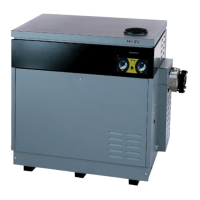Page 32
ENGLISH
Jandy
®
Pro Series, Hi-E2
®
and Hi-E2R Gas-Fired Heater
|
Installation & Operation Manual
SPEED
ADJUSTMENT
SCREW
Figure 38. Blower Speed Adjustment.
+
-
4.70
Figure 37. Unred venturi differential measurement.
4.6.4 Fuel Gas Type and Gas Orice Size
Zodiac
®
congures its heaters for natural gas with 0.60
specic gravity and 1035 BTU/Ft3 or for propane gas
with 1.52 specic gravity and 2500 BTU/Ft3. Required
gas orices are listed in the replacement parts list. Consult
your Jandy Pro Series representative if the available gas is
substantially different.
4.6.5 High Elevation Operation
The venturi combustion ow system completely
compensates for installation at elevations other than
sea level. Gas orice changes are not necessary. Unlike
conventional systems with open type burners and positive
pressure regulators, the gas orice differential pressure
is created by the air ow, and it is automatically reduced
when air density decreased. A Hi-E
2 heater commissioned
at sea level will operate at nearly the same air/gas mixture
when operated at higher elevation. Its ring rate will
decrease about 3% per 1000 feet due to the barometric
pressure change.
4.6.3.2 Combustion Air Flow
Begin by connecting the negative side of the manometer
to the venturi inlet and leaving the positive side open to
ambient, as shown in Figure 39. In a normally operating
heater, the pressure will be 0.2 to 0.6" WC less than
the ambient pressure. For a model 350 with clean lter
and no combustion air duct, the reading will be near
the middle. If combustion air is ducted to the heater,
the reading will be near the high end. If an excessive
reading is observed (i.e. more negative), ow is probably
restricted by a dirty lter or blockage in the combustion
air supply system. Correct any such problems and verify
normal operation by returning to the venturi system
checkout procedures.
Pressure readings will be less if the heater is located at an
elevation signicantly above sea level.
4.6.3.3 Flow in Heater and Vent
If the venturi inlet pressure reading is normal (or less
than normal), ow may be blocked within the heater or
in the exhaust venting, or the combustion blower may be
operating below standard. To evaluate this, connect the
negative side of the manometer to the collector pressure
tap, as shown in Figure 40, leaving the positive side open
to ambient (this requires a pressure tap with a 1/4" NPT
thread). When the heater is operating, the pressure at this
location should be about 2.8 ± 0.5" WC less than ambient
for a model 350. If a greater reading is observed (i.e.
more negative), ow is restricted within the heater, most
likely at the burner or the heat exchanger. If the reading
is substantially less (i.e. less negative), the combustion
blower is not operating properly or ow is blocked
after the blower, possibly in the vent. Correct any such
problems and verify normal operation by returning to the
venturi system checkout procedures.
Pressure readings will be less if the heater is located at an
elevation signicantly above sea level.
In servicing a Hi-E
2 heater at high elevation be aware
that the input will be naturally reduced by this amount
and that the differential pressures, as discussed in prior
sections, will also be reduced. Pressure readings at various
elevations will be approximately as follows:
Elevation
Ft (m)
Sea Level
Gas Orifice
Differential
4.0" (102 mm) WC
Unfired Venturi
Differential
4.7" (119 mm) WC
4000 (1220) 3.4 (86) 4.0 (102)
6000 (1830 3.2 (81) 3.7 (94)
8000 (2440) 2.9 (74) 3.5 (89)
10000 (3050) 2.7 (69) 3.2 (81)
The gas pressure offset is determined by the regulator spring adjustment, not air
density. It is not affected by elevation change.

